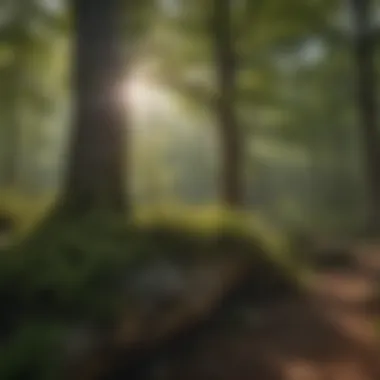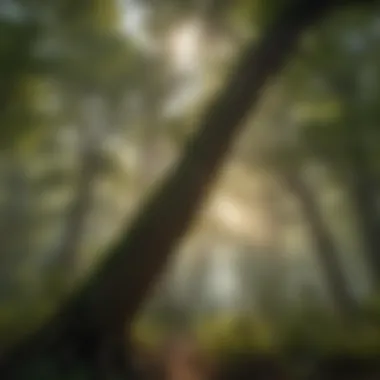Exploring the Vital Role of Ozark Canopy Cover


Intro
The Ozark Canopy covers a substantial area of the American landscape. It is vital for both ecological health and biodiversity. By examining the intricate dynamics within this forest ecosystem, one can appreciate its significance. This section introduces the components of Ozark canopy cover, highlighting its crucial role in environmental balance.
Efforts to understand this ecosystem are essential for effective conservation and management. The complexities of the canopy cover, including its composition and the interplay among species, shape the overall richness of this forest. Conducting an in-depth investigation reveals not only the species that thrive in this ecosystem but also the challenges presented by human impacts and climate change.
Understanding these nuances offers insight into ongoing conservation efforts, enhancing the dialogues around sustainable practices. Through this exploration, readers will grasp the multifaceted relationships present in the Ozark region, paving the way for informed discussions about environmental stewardship.
Prelims to Ozark Canopy Cover
The Ozark canopy cover represents an essential aspect of the regional ecology, providing a complex habitat for diverse species. It plays a significant role in maintaining biodiversity and ecological stability. Understanding the characteristics and geographical distribution of canopy cover is crucial for forestry professionals and academics. Insights into this area help in developing effective conservation strategies and management practices.
Definition and Characteristics
Ozark canopy cover is defined as the upper layer of forest formed by the foliage of trees. It serves multiple functions within the ecosystem. The canopy acts as a shelter for various species and significantly influences microclimates at ground level. Canopy height can vary widely, with some trees reaching considerable heights, shaping the structure and composition of the forest. The density of canopy cover affects the amount of light and moisture that penetrate to the forest floor, impacting the growth of understory vegetation.
Some specific characteristics include:
- Layering: The canopy consists of several layers, each hosting unique plants and animals.
- Species Composition: Various tree species contribute to the diversity of the canopy, which is characterized by a mix of deciduous and coniferous trees.
- Ecological Interactions: The canopy supports intricate relationships among species, including pollinators, herbivores, and larger predators.
Geographical Distribution
The geography of the Ozark region is defined by its unique topography and climate. The canopy cover is predominantly found in regions with suitable soil types and precipitation levels. These factors have led to the establishment of a distinct set of forests across southern Missouri, northern Arkansas, and northeast Oklahoma.
In the Ozark Highlands, the diverse elevation creates microhabitats within the canopy. This results in varying types of tree species and a mix of forest types, from oak-hickory to shortleaf pine forests.
Some key points about the geographical distribution include:
- Elevation Variations: Higher elevations often support different tree species compared to lower areas.
- Hydrology: Proximity to water sources influences canopy cover density and species selection.
Understanding the geographical distribution of canopy cover is vital for targeted conservation measures and sustainable forestry practices.
Biodiversity Within the Canopy
Biodiversity within the canopy holds significant importance in understanding the ecology of the Ozark region. A rich and varied canopy not only supports a vast array of plant and animal species but also contributes to ecosystem stability and resilience. The complex interactions found in this multilayered environment foster various ecological functions that are essential for maintaining the health of the overall biome. Higher biodiversity often translates to a more robust ecosystem, making it imperative to study and protect these interactions within the canopy.
Flora Contributions
Dominant Tree Species
Dominant tree species play a crucial role in defining the structure and function of the canopy. These trees form the upper layer and are responsible for capturing sunlight, which is vital for photosynthesis. Some common dominant species in the Ozarks include Quercus alba (white oak) and Carya ovata (shagbark hickory). Their ability to grow tall allows them to shade understory plants.
The key characteristic of these species is their adaptability to various soil types and climates, which makes them popular choices in reforestation efforts. A unique feature of dominant trees is their longevity; they can live for centuries, providing a stable environment for countless other organisms.
Understory Plants
Understory plants are equally important, providing habitat and food for many forest inhabitants. These plants thrive in the shade created by the upper canopy and often include species like Rudbeckia hirta (black-eyed Susan) and Polystichum acrostichoides (Christmas fern). Their key characteristic is their ability to adapt to low-light conditions. This trait makes them crucial for the survival of many herbivores and insects that depend on them. The unique feature of understory plants is their role in soil stabilization and moisture retention. They contribute to nutrient cycling, which supports the overall health of the forest ecosystem.
Fauna Interactions
Birds
Birds are essential players in the dynamics of the canopy. They contribute to seed dispersal and pollination, which are vital processes for plant reproduction. Numerous bird species, such as the Eastern Bluebird and Wood Thrush, can be found in Ozark forests. A key characteristic of these birds is their adaptability to various habitats. Their unique features include vocalizations used for communication and territory establishment, which play significant roles in maintaining population dynamics within the ecosystem.
Insects
Insects significantly influence canopy health through their interactions with flora and fauna. They serve as pollinators and breakdown organic matter, facilitating nutrient cycling. Common insects like butterflies and ants showcase remarkable diversity in this environment. A key characteristic of these insects is their ability to thrive in specific niches.
Their unique features, such as camouflage and pheromone communication, benefit the overall ecology of the canopy, supporting numerous other species.
Mammals


Mammals within the canopy contribute to ecological balance through herbivory and seed dispersal. Species such as the Eastern Chipmunk and various squirrels are prevalent in these habitats. A key characteristic is their agility in navigating the numerous layers of the trees.
They have unique adaptations, like gripping and climbing abilities, which help them exploit different food resources while serving as prey for higher predators, thus maintaining food web dynamics.
Understanding the multifaceted interactions among flora and fauna in the Ozark canopy is key to fostering and preserving its biodiversity.
Ecological Functions of Canopy Cover
The ecological functions of canopy cover are pivotal to maintaining the health and stability of forest ecosystems, particularly in the Ozark region. The canopy acts as a crucial interface between the earth and atmosphere, influencing numerous ecological processes. Understanding these functions helps elucidate the broader impact of canopy cover on biodiversity, climate regulation, and water resources.
Climate Regulation
Canopy cover plays a significant role in climate regulation. Trees and other plants in the canopy absorb carbon dioxide, mitigating the greenhouse effect. This process is essential in combating climate change as it contributes to reducing atmospheric CO2 levels. The canopy also helps in regulating temperatures. It provides shade, which leads to cooler soil and air temperatures, creating a more stable environment for understorey flora and fauna. Additionally, the transpiration process, where trees release water vapor, contributes to local humidity and can even influence precipitation patterns. This intricate balance aids in creating microclimates within the forest.
Water Cycle Support
The water cycle support function of canopy cover cannot be overstated. Canopies intercept precipitation, reducing the impact of rain on the forest floor. This interception reduces soil erosion and promotes water infiltration, leading to healthier soil conditions. Furthermore, canopy trees absorb significant quantities of groundwater through their roots and release water through transpiration. This process contributes to maintaining regional hydrology by returning moisture to the atmosphere. It creates a cycling of water that is vital for plant growth and sustains the overall ecosystem. The retention of water by canopy cover is particularly crucial in areas prone to drought, highlighting its importance in stabilizing water resources.
"The flexibility of the Ozark canopy plays a key role in sustaning both terrestrial and aquatic ecosystems by regulating extreme water fluctuations."
In summary, the ecological functions of canopy cover extend well beyond the visible tree line. Understanding these functions provides insights into the complex interrelationships within forest ecosystems and the essential services they provide. Recognizing these dynamics is critical for effective conservation and management practices.
Canopy Structure and Layers
The canopy structure of the Ozark forests is an essential component of their ecology. Understanding how the different layers function allows for a better grasp of their role in biodiversity, climate regulation, and the overall health of these ecosystems. The canopy is generally divided into three main layers: the upper canopy, lower canopy, and the forest floor. Each of these strata has unique characteristics and functions, contributing to the forest's complexity and resiliency.
Vertical Stratification
Vertical stratification refers to the layering of vegetation in a forest. In the Ozark region, this stratification is especially pronounced, leading to diverse habitats and ecological niches.
Upper Canopy
The upper canopy layer consists of the tallest trees, often towering above the rest of the forest. This level contributes significantly to light capture, which is crucial for photosynthesis. The trees in this layer are generally broad-leaved and receive full sunlight. One key characteristic of the upper canopy is its capacity to create microclimates beneath. This affects humidity and temperature, benefiting various understory species.
Moreover, the upper canopy acts as a natural barrier against strong winds. However, a disadvantage is that when tree density is high, competition for light increases, resulting in some trees not thriving.
Understanding the dynamics of the upper canopy is important for forestry professionals when assessing forest health and planning management strategies.
Lower Canopy
The lower canopy layer is composed of smaller trees and shrubs that thrive in partial shade. This layer plays a vital role in supporting understory biodiversity. A key characteristic of the lower canopy is its rich accumulation of foliage, providing habitat and food sources for various species. The plants found here often have adaptations that allow them to photosynthesize in lower light situations.
However, this layer can be more vulnerable to disturbances such as invasive species. These invaders can reduce the native diversity that sustains the ecosystem. It’s crucial to monitor the health of the lower canopy to maintain ecological balance within the Ozark region.
Forest Floor
The forest floor, the final layer of the canopy structure, hosts a unique set of plants and organisms. This layer is primarily shaded, with a rich carpet of leaf litter and decomposing organic matter. One key characteristic of the forest floor is its role in nutrient cycling, as it harbors a variety of fungi and microorganisms essential for breaking down organic matter.
The forest floor is beneficial for seedling establishment due to its rich soils and moisture retention capabilities. However, its vulnerability manifests in susceptibility to soil compaction and erosion, often resulting from human activity. Preservation of this layer is critical for the health and sustainability of the entire ecosystem.
Understanding the multifaceted relationships between these layers can inform better conservation practices and management strategies that support the entire Ozark canopy ecosystem.
Impact of Climate Change on Canopy Dynamics
The influence of climate change on canopy dynamics is significant, especially in the context of the Ozark region. Canopy cover plays a critical role in forest ecosystems, acting as a buffer to environmental changes. Higher surface temperatures and variable precipitation patterns can disrupt the delicate balance of these ecosystems. This section will explore how temperature variations and changes in precipitation affect the canopy, thereby altering the overall health and resilience of these environments.
Temperature Variations
Temperature fluctuations pose a direct threat to the structural integrity and functional capacity of the Ozark canopy. Forests, including the Ozark, rely on a specific range of temperatures to thrive. When temperatures rise unexpectedly, trees may experience stress. This stress can lead to reduced growth rates, impacting tree health and the biodiversity that depend on them.


- Physiological Stress: When temperatures exceed optimal ranges, trees may struggle to photosynthesize efficiently. This can result in stunted growth and, over time, lead to mortality.
- Increased Vulnerability to Pests and Diseases: Warmer temperatures can enhance pest populations, like beetles, that target weakened trees. This, in turn, can trigger a cascade effect on overall forest health.
- Altered Growth Seasons: Changes in temperature can shift growth periods. For instance, early springs paired with frost could damage tender shoots, impacting reproductive cycles of trees.
These factors illustrate the importance of understanding local temperature trends and their implications on canopy structure.
Precipitation Changes
Precipitation patterns are also changing due to climate change, influencing canopy dynamics notably. The Ozarks, like many regions, rely heavily on predictable rainfall for ecological balance. Variations in precipitation can lead to several outcomes.
- Water Availability: Changes in rainfall can affect water availability for trees, essential for growth and sustainability. Inconsistent moisture levels can lead to drought stress and inhibit growth.
- Erosion of Soil Health: Heavy rains can cause soil erosion, impacting root systems. As roots are compromised, trees become less stable and more susceptible to falling.
- Altered Ecosystem Interactions: The relationships between flora and fauna may shift as water availability changes. Certain plant species may thrive while others die off, altering the habitat for birds, insects, and mammals.
The changes in precipitation not only stress the canopy itself but also reinforce the complex interactions within the ecosystem, making it essential to monitor these shifts.
Human Influences on Canopy Health
The impact of human activities on canopy health is profound and multifaceted. Understanding these influences is essential for professionals engaged in forestry and conservation fields. Human actions such as deforestation and urban development can disrupt the delicate balance of ecosystems, leading to consequences that affect biodiversity and the environment at large.
Deforestation Issues
Deforestation remains one of the most critical threats to the Ozark canopy cover. Large-scale logging operations result in a significant reduction of tree cover, diminishing habitat for many species. The removal of trees not only leads to biodiversity loss but also alters the microclimate.
- Consequences of Deforestation:
- Habitat fragmentation that threatens wildlife populations
- Increased soil erosion which degrades land quality
- Disruption of water cycles affecting local hydrology
These effects can set off a chain reaction, impacting not only the biological flora and fauna but also the humans relying on these systems for ecosystem services. Through proper management practices, it is possible to mitigate the adverse effects of deforestation while still meeting timber demands.
Urban Development Effects
Urban development poses an additional challenge to canopy health. As cities expand, green spaces are often sacrificed for housing and infrastructure. This urban sprawl reduces the amount of canopy cover, leading to further stresses on wildlife and plant species dependent on undisturbed habitats.
- Urbanization Challenges:
- Increase in impermeable surfaces that lead to water runoff issues
- Pollution that can hinder tree growth and health
- Greater human-wildlife conflicts as animals lose their natural habitats
Urban development can have long-term ecological ramifications if not approached sustainably. Incorporating green spaces and preserving existing forests within urban planning can create a balance between development and environmental preservation.
Protecting canopy health is not just an environmental concern; it is essential for sustaining the quality of life for all species, including humans.
In summary, the influences of human activity on canopy health in the Ozarks cannot be underestimated. Addressing both deforestation and urban development is crucial for the survival of this unique ecosystem. Through thoughtful intervention and management, the resilience of canopy cover can be preserved for future generations.
Conservation Strategies for Canopy Preservation
The preservation of canopy cover in the Ozarks is vital not only for the health of the forests but also for the wider ecological balance. Various strategies can effectively contribute to maintaining the integrity of this essential layer of the ecosystem. Through targeted efforts in conservation, it is possible to mitigate the adverse effects of human activity and climate change.
Protected Areas
Establishing protected areas is one of the most effective strategies for maintaining canopy cover. These areas serve as sanctuaries for diverse species and ecosystems. In the context of the Ozarks, protecting significant forested regions helps maintain habitat for flora and fauna that thrive in these conditions.
In these protected zones, activities that could harm the ecosystems, like logging or development, face strict regulations. The benefits of such areas are manifold:
- Biodiversity Conservation: Protected areas preserve the genetic resources necessary for the resilience of species.
- Ecosystem Services: They play a crucial role in providing clean air and water, regulating temperatures, and maintaining soil health.
- Research Opportunities: They offer settings for scientific studies, which can inform conservation practices and policies.
The creation of walk-in parks and nature reserves in the Ozarks can enhance public appreciation for these ecosystems. When communities become engaged with these areas, it encourages advocacy and support for their ongoing protection.
Sustainable Forestry Practices
Sustainable forestry practices are crucial in balancing economic demands with ecological preservation. These practices involve methods that allow for resource extraction without compromising the future health of forest ecosystems.


Key aspects of sustainable forestry include:
- Selective Logging: Instead of clear-cutting, selective logging minimizes disturbance by removing only certain trees. This method helps protect the understory and ensures canopy cover remains intact.
- Agroforestry: Integrating agriculture and forestry can allow for productive land use while maintaining a healthy canopy. This can include planting crops alongside trees, which supports biodiversity and soil health.
- Reforestation: Planting trees is crucial to restore areas that have been degraded or deforested. Selecting native species helps ensure that the new growth supports local wildlife and maintains ecosystem functions.
"Sustainable forestry practices not only contribute to the economic vitality of communities but also ensure the forest's ecological integrity for generations to come."
In summary, the effective conservation of canopy cover in the Ozarks hinges on strategies that include the establishment of protected areas and the adoption of sustainable forestry practices. These efforts are instrumental in fostering resilient ecosystems that can withstand the pressures of climate change and human impact.
Research and Monitoring of Canopy Cover
Research and monitoring of canopy cover is essential for understanding the dynamics of Ozark ecosystems. This area of study provides valuable insights into forest health, biodiversity, and the impacts of environmental changes. With increased threats from climate change and human activities, effective monitoring can guide conservation efforts and inform management practices.
Ongoing research helps identify changes in canopy structure and composition over time. By analyzing these changes, scientists can predict how these forests will respond to various stressors, such as pests, diseases, and altered weather patterns. Furthermore, quantifying canopy cover allows for the assessment of habitat availability for various species. This is crucial for maintaining biodiversity in the Ozarks.
Remote Sensing Technologies
Remote sensing technologies have revolutionized the way we study canopy cover. These methods offer a broad perspective and collect data with high accuracy and efficiency.
- Satellite Imagery: This tool provides comprehensive insights on large areas. You can analyze changes in forest cover over time. Various satellites, such as Landsat, produce images that help map and interpret vegetation.
- LiDAR (Light Detection and Ranging): This technique uses laser pulses to generate precise three-dimensional information about the canopy structure. It is particularly useful in determining canopy height and biomass.
- Aerial Drone Surveys: Drones have become popular for their ability to capture high-resolution images from multiple angles. This can assist in monitoring specific areas that may be more difficult to access on the ground.
All these techniques enhance the ability to monitor ozone layer health effectively and aid in decision-making processes for conservation strategies.
Field Studies and Data Collection
Field studies are an invaluable complement to remote sensing technologies. They provide ground-truthing data, validating findings obtained from satellite imagery and other remote methodologies. They focus on the actual conditions present in the field, allowing researchers to gather more nuanced information about canopy dynamics.
In these studies, researchers generally:
- Assess tree species diversity and abundance within the canopy.
- Monitor understory vegetation health.
- Collect data on animal interactions by observing wildlife activity.
The data derived from these studies is crucial for crafting effective management recommendations. Moreover, collaboration between scientists and local stakeholders fosters a better understanding of the ecological importance of canopy cover to the community.
Overall, research and monitoring efforts cultivate a comprehensive understanding of Ozark canopy cover. They not only highlight the significance of these forest ecosystems but also emphasize the role of community participation in conservation initiatives that uphold the integrity of the environment.
Public Awareness and Education
Public awareness and education play a crucial role in fostering a deeper understanding of Ozark canopy cover. An informed public can support conservation efforts and engage in sustainable practices. This section outlines key aspects of why raising awareness about the Ozark canopy is essential. By enhancing knowledge about the ecological significance of this forest layer, communities can better appreciate their natural surroundings. Furthermore, such understanding can nurture stewardship among the residents, vital for long-term conservation.
The benefits of increasing public awareness include:
- Enhancing Ecological Literacy: Knowledge of the local ecosystem can empower individuals to make informed decisions.
- Supporting Conservation Initiatives: Educated communities are more likely to participate in local conservation programs.
- Encouraging Sustainable Practices: Understanding the impact of human activity on forest health can lead to more sustainable behaviors.
Additionally, it is critical to consider how educational topics can be introduced effectively. Strategies might involve leveraging local partnerships, educational institutions, and community organizations. Engaging the public through workshops or informational sessions can lead to increased interest and participation in conservation activities.
Engaging Communities
Engaging communities is essential for building a support network around the Ozark canopy cover. This can be accomplished by promoting participation in ecological projects. For instance, volunteer programs for tree planting or monitoring species can provide hands-on experience.
Utilizing social media platforms like Facebook can help spread information quickly. Local events can be organized to showcase the importance of canopy cover, allowing individuals to connect with their environment. These initiatives also foster a sense of community and shared responsibility among participants.
Informational Outreach
Informational outreach encompasses various methods of disseminating knowledge about the Ozark canopy. The objective is to reach a broad audience, using diverse channels to maximize impact.
- Workshops and Seminars: Conducting events focused on canopy cover education can answer questions and address concerns.
- Educational Materials: Creating brochures, infographics, and online resources can provide accessible information.
- Collaboration with Schools: Partnering with educational institutions can ensure the inclusion of environmental topics in school curriculums.
Outreach efforts should aim to highlight the integral role of the canopy in maintaining biodiversity and ecological balance.
"An informed community can truly make a difference in conservation efforts, ensuring the longevity of vital resources like the Ozark canopy."
By investing in education and outreach, stakeholders can build a sustainable future for the Ozark's unique ecological heritage.



